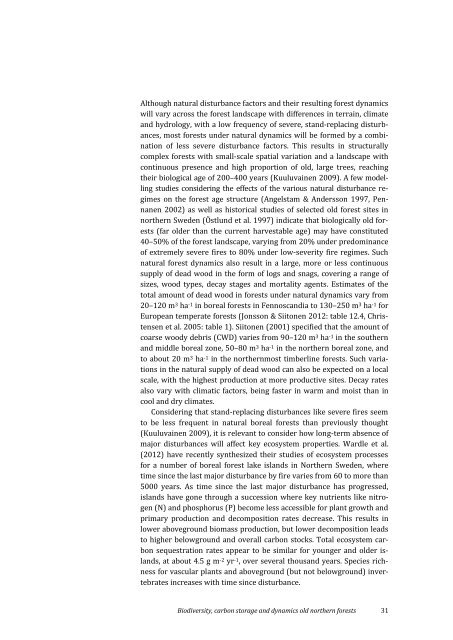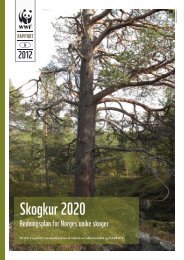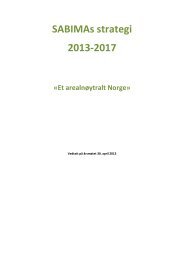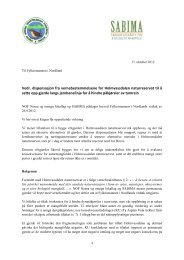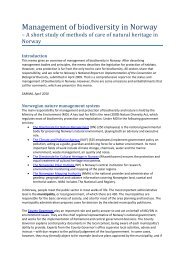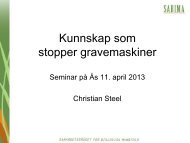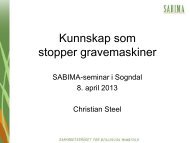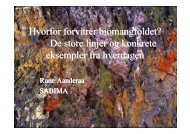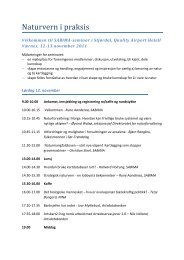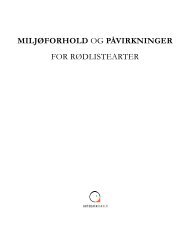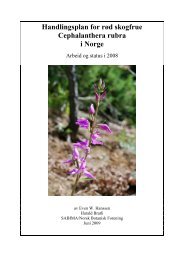Biodiversity, carbon storage and dynamics of old northern ... - BPAN.fi
Biodiversity, carbon storage and dynamics of old northern ... - BPAN.fi
Biodiversity, carbon storage and dynamics of old northern ... - BPAN.fi
You also want an ePaper? Increase the reach of your titles
YUMPU automatically turns print PDFs into web optimized ePapers that Google loves.
Although natural disturbance factors <strong>and</strong> their resulting forest <strong>dynamics</strong><br />
will vary across the forest l<strong>and</strong>scape with differences in terrain, climate<br />
<strong>and</strong> hydrology, with a low frequency <strong>of</strong> severe, st<strong>and</strong>-replacing disturbances,<br />
most forests under natural <strong>dynamics</strong> will be formed by a combination<br />
<strong>of</strong> less severe disturbance factors. This results in structurally<br />
complex forests with small-scale spatial variation <strong>and</strong> a l<strong>and</strong>scape with<br />
continuous presence <strong>and</strong> high proportion <strong>of</strong> <strong>old</strong>, large trees, reaching<br />
their biological age <strong>of</strong> 200–400 years (Kuuluvainen 2009). A few modelling<br />
studies considering the effects <strong>of</strong> the various natural disturbance regimes<br />
on the forest age structure (Angelstam & Andersson 1997, Pennanen<br />
2002) as well as historical studies <strong>of</strong> selected <strong>old</strong> forest sites in<br />
<strong>northern</strong> Sweden (Östlund et al. 1997) indicate that biologically <strong>old</strong> forests<br />
(far <strong>old</strong>er than the current harvestable age) may have constituted<br />
40–50% <strong>of</strong> the forest l<strong>and</strong>scape, varying from 20% under predominance<br />
<strong>of</strong> extremely severe <strong>fi</strong>res to 80% under low-severity <strong>fi</strong>re regimes. Such<br />
natural forest <strong>dynamics</strong> also result in a large, more or less continuous<br />
supply <strong>of</strong> dead wood in the form <strong>of</strong> logs <strong>and</strong> snags, covering a range <strong>of</strong><br />
sizes, wood types, decay stages <strong>and</strong> mortality agents. Estimates <strong>of</strong> the<br />
total amount <strong>of</strong> dead wood in forests under natural <strong>dynamics</strong> vary from<br />
20–120 m 3 ha -1 in boreal forests in Fennosc<strong>and</strong>ia to 130–250 m 3 ha -1 for<br />
European temperate forests (Jonsson & Siitonen 2012: table 12.4, Christensen<br />
et al. 2005: table 1). Siitonen (2001) speci<strong>fi</strong>ed that the amount <strong>of</strong><br />
coarse woody debris (CWD) varies from 90–120 m 3 ha -1 in the southern<br />
<strong>and</strong> middle boreal zone, 50–80 m 3 ha -1 in the <strong>northern</strong> boreal zone, <strong>and</strong><br />
to about 20 m 3 ha -1 in the <strong>northern</strong>most timberline forests. Such variations<br />
in the natural supply <strong>of</strong> dead wood can also be expected on a local<br />
scale, with the highest production at more productive sites. Decay rates<br />
also vary with climatic factors, being faster in warm <strong>and</strong> moist than in<br />
cool <strong>and</strong> dry climates.<br />
Considering that st<strong>and</strong>-replacing disturbances like severe <strong>fi</strong>res seem<br />
to be less frequent in natural boreal forests than previously thought<br />
(Kuuluvainen 2009), it is relevant to consider how long-term absence <strong>of</strong><br />
major disturbances will affect key ecosystem properties. Wardle et al.<br />
(2012) have recently synthesized their studies <strong>of</strong> ecosystem processes<br />
for a number <strong>of</strong> boreal forest lake isl<strong>and</strong>s in Northern Sweden, where<br />
time since the last major disturbance by <strong>fi</strong>re varies from 60 to more than<br />
5000 years. As time since the last major disturbance has progressed,<br />
isl<strong>and</strong>s have gone through a succession where key nutrients like nitrogen<br />
(N) <strong>and</strong> phosphorus (P) become less accessible for plant growth <strong>and</strong><br />
primary production <strong>and</strong> decomposition rates decrease. This results in<br />
lower aboveground biomass production, but lower decomposition leads<br />
to higher belowground <strong>and</strong> overall <strong>carbon</strong> stocks. Total ecosystem <strong>carbon</strong><br />
sequestration rates appear to be similar for younger <strong>and</strong> <strong>old</strong>er isl<strong>and</strong>s,<br />
at about 4.5 g m -2 yr -1 , over several thous<strong>and</strong> years. Species richness<br />
for vascular plants <strong>and</strong> aboveground (but not belowground) invertebrates<br />
increases with time since disturbance.<br />
<strong>Biodiversity</strong>, <strong>carbon</strong> <strong>storage</strong> <strong>and</strong> <strong>dynamics</strong> <strong>old</strong> <strong>northern</strong> forests 31


